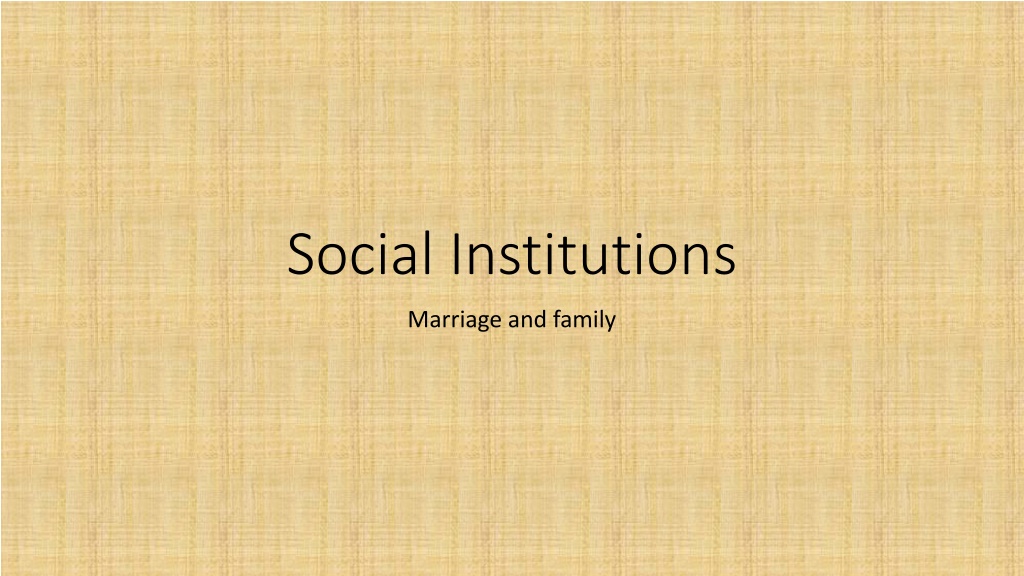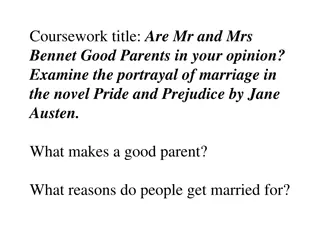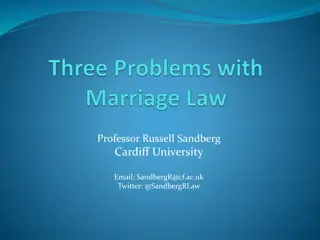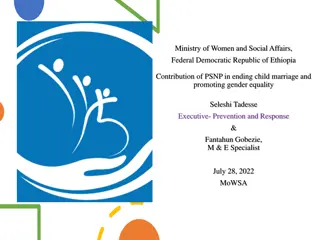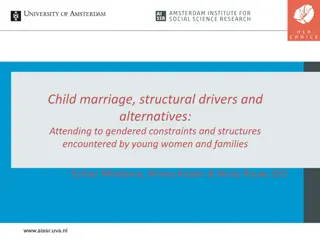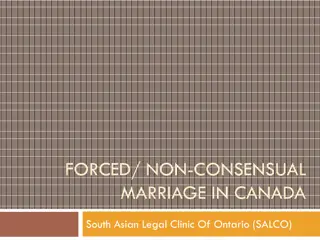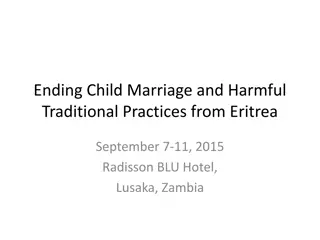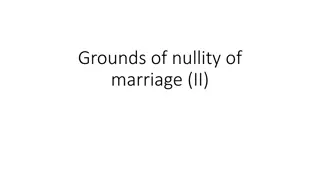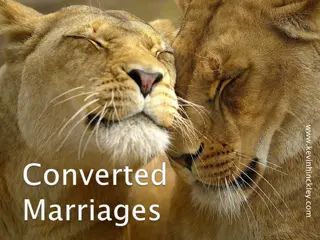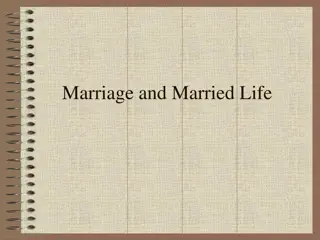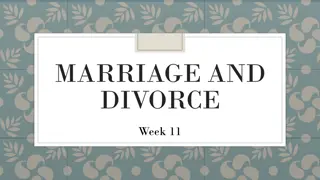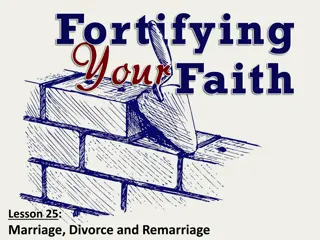Understanding Marriage and Types: A Comprehensive Overview
Marriage is a universally recognized social contract, varying across cultures and taking different forms. Types of marriage include polygyny, polyandry, and monogamy, each with unique characteristics and implications. This article explores the definitions, practices, and cultural variations of marriage and family institutions.
Download Presentation

Please find below an Image/Link to download the presentation.
The content on the website is provided AS IS for your information and personal use only. It may not be sold, licensed, or shared on other websites without obtaining consent from the author. Download presentation by click this link. If you encounter any issues during the download, it is possible that the publisher has removed the file from their server.
E N D
Presentation Transcript
Social Institutions Marriage and family
Marriage Marriage Marriage is a legally recognized social contract between two people, traditionally based on a sexual relationship and implying a permanence of the union. Marriage is a cultural universal, and like family, it takes many forms. Marriage is one of the universal social institutions established to control and regulate the life of mankind. It is closely associated with the institution of family. Infact both the institutions are complementary to each other. It is an institution with different implications in different cultures. Its purposes, functions and forms may differ from society to society but it is present everywhere as an institution. Definition of Marriage by Authors Westermarck in 'History of Human marriage' defines marriage as the more or less durable connection between male and female lasting beyond the mere act of propagation till after the birth of offspring. According to Malinowski marriage is a contract for the production and maintenance of children. Robert Lowie describes marriage as a relatively permanent bond between permissible mates.
Polygyny Polygyny is a form of marriage in which one man married more than one woman at a given time. Polygyny is more popular than polyandry but not as universal as monogamy. It was a common practice in ancient civilizations. At present it may be present in primitive tribes like Crow Indians, Baigas and Gonds of India. Polygyny is of two types: Sororal polygyny It is a type of marriage in which the wives are invariably the sisters. It is often called sororate. The Latin word Soror stands for sister. When several sisters are simultaneously or potentially the spouses of the same man the practice is called sororate. It is usually observed in those tribes that Non-sororal polygyny It is a type of marriage in which the wives are not related as the sisters. pay a high bride price.
Polyandry Polyandry is the marriage of one woman with several men. It is practiced among the Marquesan Islanders of Polynesia, The Bahama of Africa and tribes of Samoa. In India among tribes of Tiyan, Toda, Kota, Khasa and Ladakhi Bota it is still prevalent. Polyandry is of two. Fraternal polyandry and non fraternal polyandry. Fraternal polyandry When several brothers share the same wife, the practice can be called fraternal polyandry. This practice of being mate, actual or potential to one's husband's brothers is called levirate. It is prevalent among Non - fraternal polyandry In this type the husbands need not have any close relationship prior to the marriage. The wife goes to spend some time with each husband. So long as a woman lives with one of her husbands, the others have no claim over her. Polyandry has its own implications. It gives rise to the problem of determining biological paternity of the child. Among the Todas one of the husbands goes through what is called a bow and arrow ceremony with the woman and thereby becomes the legal father of her child. Among the Samoans, the children after the first few years are given the liberty to choose their parents for their permanent stay. The selected parent becomes the actual father of the children. the Todas in India.
Monogamy Monogamy is a form of marriage in which one man marries the woman. It is most common form of the marriage found among in the societies around the world. According to Westermarck monogamy is as old as humanity. Monogamy is universally practiced providing marital opportunity and satisfaction to all the individuals. It promotes love and affection between husband and wife. It contributes to family peace, solidarity and happiness. Monogamous marriage is stable and long lasting. It is free from conflicts that are commonly found in polyandrous and polygamous families. Monogamous marriage gives greater attention to the socialization of their children. Women are given very low position in polygyny where their rights are never recognized. In monogamy women enjoy better social status. There are two types of monogamy.
Serial monogamy In many societies individuals are permitted to marry again often on the death of the first spouse or after divorce but they cannot have more than one spouse at one and the same time. Straight monogamy: In straight monogamy the remarriage of the individuals is not allowed. Group Marriage Group marriage means the marriage of two or more women with two or more men. Here the husbands are common husbands and wives are common wives. Children are regarded as the children of the entire group as a whole.
Rules of marriage Exogamy Endogamy
Exogamy: It is a rule of marriage in which an individual has to marry outside his own group. It prohibits marrying within the group. The so-called blood relatives shall neither have marital connections nor sexual contacts among themselves. Forms of exogamy: Gotra Exogamy: The Hindu practice of one marrying outside one's own gotra. Pravara Exogamy: Those who belong to the same pravara cannot marry among themselves. Village Exogamy: Many Indian tribes like Naga,Garo,Munda etc have the practice of marrying outside their village. Pinda Exogamy: Those who belong to the same panda or sapinda( common parentage) cannot marry within themselves.
Isogamy: (status)Anisogamy: It is an asymmetric marriage alliance between two individuals belonging to different social statuses. It is of two forms - Hypergamy and Hypogamy. Hypergamy: It is the marriage of a woman with a man of higher Varna or superior caste or family. Hypogamy: It is the marriage of high caste man with a low caste woman. It is the marriage between two equals Orthogamy: It is the marriage between selected groups.Cerogamy: It is two or more men get married to two or more women. Anuloma marriage: It is a marriage under which a man can marry from his own caste or from those below, but a woman can marry only in her caste or above. Pratiloma marriage: It is a marriage of a woman to a man from a lower caste which is not permitted.
THANK YOU. STAY SAFE Presented by PAYEL SARKAR.
